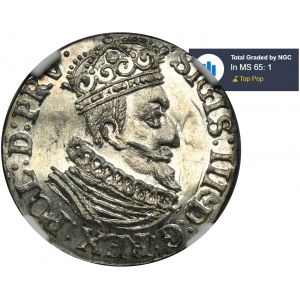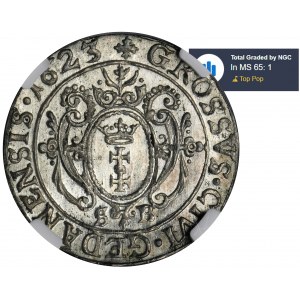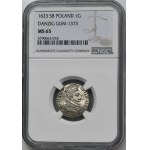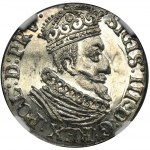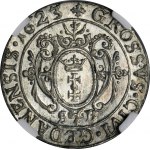Phenomenal piece especially for the first among late Sigismund III Vasa's Gdansk pennies.
The variety with PRV on the obverse, with the letters S-B, with an ornamental cartouche of the coat of arms of the city of Danzig.
Absolutely mint art. Exquisitely preserved coin with intense mirror on both sides.
A rare item, and extremely rare in the condition presented.
The only piece with the highest grade in the NGC registry.
Coin to the most stringent in terms of condition of the Royal Polish collection.
Highly recommended!
The background of the monetary history of the Republic of Poland during the reign of Sigismund Vasa was the progressive monetary crisis caused by the situation in Germany and the influx of spodleniated German coinage into Poland. Initially, the mint rate was determined by Stefan Batory's ordinance of 1580. With the crisis deepening, in 1601 it was decided to raise the mint rate, i.e. devalue the denominations in circulation. The following years saw further legislation lowering the silver content of various denominations. Of these, the most important was the Ordinance of 1623. It introduced a stable monetary system, based on the monetary system of the Empire. During the reign of Sigismund III, new denominations appeared in the Polish-Lithuanian Commonwealth - three-cornered coins, halves and orts. On the other hand, in 1621, the highest denomination in the history of Polish money - the hundred-drachma - was minted at the Bydgoszcz mint. This was the crowning achievement of the intensive issuance of gold coins during the reign of Sigismund III. Crown mints (Olkusz, Wschowa, Poznań, Malbork, Bydgoszcz, Lublin, Kraków, Warsaw), Lithuanian mints (Vilnius), municipal mints (Gdańsk, Elbląg, Toruń, Riga, Poznań, Wschowa) and a private mint in Łobżenica worked during this period. Sigismund Vasa's Swedish coins were issued by mints in Stockholm, Rewal and Malbork. In 1627, a decision was made to stop issuing small coinage. This decision remained in force until 1650.
The value of the penny changed three times during the period in question. This was related to the devaluation of the denomination introduced by successive minting ordinances. At the beginning of the reign of Sigismund Vasa, pennies were minted according to the 1580 ordinance of Stefan Batory. They weighed an average of 1.904 g and contained 0.684 g of pure silver. In the first period (1593-1599), pennies were issued by mints in Olkusz (in the Olkusz mint the pennies were stamped using a rolling machine), Bydgoszcz, Poznan, Wschowa and Lublin (only in the Lublin mint in the first period inscribed pennies were minted next to portrait pennies, without the monarch's image). At present, pennies from this period belong to rare and very rare coins. In 1604, by a resolution of the Warsaw Sejm, the minting rate of pennies was raised, significantly lowering the silver content. In the second period (1603-1616), pennies weighed an average of 1.580 g and contained 0.571 g of pure bullion. They were issued by mints in Krakow, Bydgoszcz, Vilnius, Gdansk and Riga. At the Cracow mint, pennies were issued between 1603 and 1616. The 1603 stamping predated the 1604 resolution of the Warsaw Sejm. Until 1605 and incidentally in 1608, the pennies were stamped using a cylinder machine, while in other years they were minted. At the Bydgoszcz mint, pennies were minted in 1613 and 1614. Vilnius issues were in 1617-1615. In Gdansk, pennies were issued only in 1614 were proof coins, which did not enter circulation. Catalogs estimate their rarity at R8. Stamps for them were made by Samuel Ammon. Riga pennies were minted in 1616-1617, and they had an iconographic scheme characteristic of half-tracks, but the word "GROS(SUS)" was placed in the obverse inscription. In the third period (1623-1627), the issuance of pennies was based on the ordinance of 1623. It assumed an average weight of pennies of 1.045 g and a silver content of 0.294 g. The minting production of this period was carried out by establishments in Bydgoszcz and Cracow (1623-1627), Vilnius (1625-1627) and Gdansk (1623-1627).
